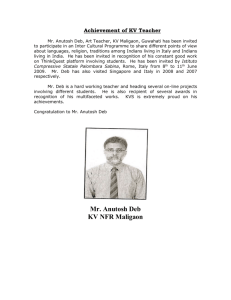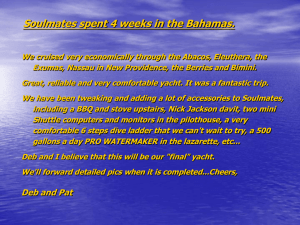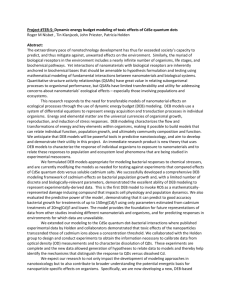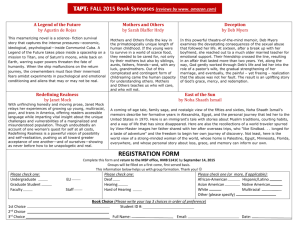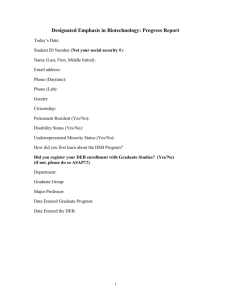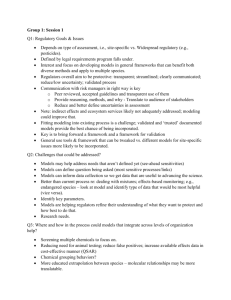Links between aging & energetics
advertisement
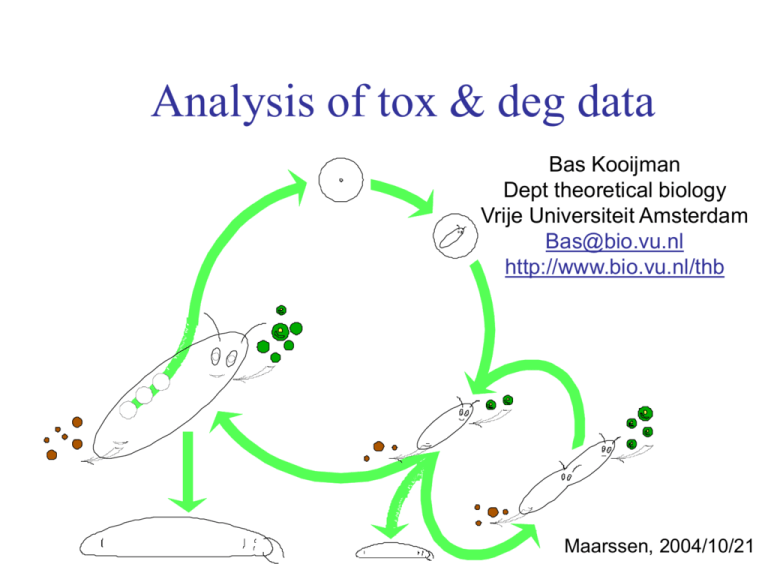
Analysis of tox & deg data Bas Kooijman Dept theoretical biology Vrije Universiteit Amsterdam Bas@bio.vu.nl http://www.bio.vu.nl/thb Maarssen, 2004/10/21 Contents Introduction • DEB theory • DEB laboratory • Effects of toxicants sublethal effects tumour induction & growth lethal effects extrapolation • Biodegradation microbial flocs co-metabolism adaptation • Foundation Biomass imbedding modes of operation Maarssen, 2004/10/21 Dynamic Energy Budget theory for metabolic organization • links levels of organization molecules, cells, individuals, populations, ecosystems scales in space and time: scale separation • interplay between biology, mathematics, physics, chemistry, earth system sciences • framework of general systems theory • quantitative; first principles only equivalent of theoretical physics • fundamental to biology; many practical applications (bio)production, medicine, (eco)toxicity, climate change Space-time scales space Each process has its characteristic domain of space-time scales system earth ecosystem population individual cell molecule When changing the space-time scale, new processes will become important other will become less important Individuals are special because of straightforward energy/mass balances time Some DEB pillars • life cycle perspective of individual as primary target embryo, juvenile, adult (levels in metabolic organization) • life as coupled chemical transformations (reserve & structure) • time, energy & mass balances • surface area/ volume relationships (spatial structure & transport) • homeostasis (stoichiometric constraints via Synthesizing Units) • syntrophy (basis for symbioses, evolutionary perspective) • intensive/extensive parameters: body size scaling Basic DEB scheme food feeding defecation faeces assimilation reserve somatic maintenance growth structure 1- maturity maintenance maturation reproduction maturity offspring Electronic DEB laboratory http://www.bio.vu.nl/thb/deb/deblab/ (free download site) DEBtool for research applications open source (Octave, Matlab) covers full range of DEB research (fundamental + applied) advanced regression routines for simultaneous model fitting DEBtox for routine ecotoxicity applications load module DEBtox Present tasks: analysis of bioassays on survival, body growth, reproduction, population growth NEC (including profile likelihood), ECx-time curves OECD/ISO report on analysis of toxicity data NOEC methods: not recommended, for historic continuity only ECx methods: fixed exposure times only, descriptive Biology-based methods: DEBtox; process-based OECD-meeting Braunschweig 1996: stimulate exposure-explicit regression methods DEBtox: only exposure time-explicit method presently available Near-future extensions: biodegradation models, multi-sample analysis, population consequences profile likelihoods for more parameters (elimination rate, toxicity parameters) Future extensions: more bioassays, sensitivity-variations, ecosystem effects, predictions based on physical chemistry mixture toxicity, coupling to exposure models, implementation in environmental risk assessment Concentration ranges of chemicals • too little def: variations in concentration come with variations in effects • enough def: variations in concentration within this range hardly affect physiological behaviour of individuals • too much def: variations in concentration come with variations in effects e.g. water concentration can be too much even for fish no basic difference between toxic and non-toxic chemicals “too little” and “enough” can have zero range for some chemicals Implication: lower & upper NEC for each compound Effects on organisms • Process-based perspective on disturbances chemicals, temperature, parasites, noise exposure-time explicit methods (response surface) • Primary target: individuals some effects at sub-organism level can be compensated (NEC) • Effects on populations derived from individuals energy budget basic to population dynamics • Parameters of budget model individual specific and (partly) under genetic control Models for toxic effects Three model components: • kinetics external concentration internal concentration example: one-compartment kinetics • change in target parameter(s) internal concentration value of target parameter(s) example: linear relationship • physiology value of parameter endpoint (survival, reproduction) example: DEB model Modes of action of toxicants assimilation food maintenance costs defecation feeding faeces growth costs assimilation reproduction costs reserve somatic maintenance maint 1- 7 growth structure u tumour 6 hazard to embryo maturity maintenance maturation reproduction maturity offspring 6 tumour induction 7 endocr. disruption 8 lethal effects: hazard rate Mode of action affects translation to pop level Toxic effect on survival Effect of Dieldrin on survival of Poecilia One-compartment kinetics Hazard rate is linear in internal concentration killing rate 0.038 l g-1 d-1 elimination rate 0.712 d-1 NEC 4.49 g l-1 DEB-based effects on body growth Indirect effects indicator: effects on ultimate size at constant food • decrease of assimilation rate (food intake, digestion) • increase of specific maintenance costs Direct effects indicator: no effects on ultimate size at constant food • increase of costs for synthesis of biomass (structural) weight1/3, mg1/3 Effect on assimilation time, d CuCl2 mg/kg Data from Klok & de Roos 1996 NEC = 4.45 mg CuCl2 /kg on Lumbricus rubellus DEB-based effects on reproduction Indirect effects indicator: effects on onset of reproduction • decrease of assimilation rate (food intake, digestion) • increase of specific maintenance costs • increase of costs for synthesis of biomass (structural) Direct effects indicator: no effects on onset of reproduction • increase of costs for the synthesis of offspring • decrease of survival probability at birth Direct effect on reproduction cum. # young/female 0 g Cd/l 0.2 0.4 0.8 1 2 time, d Effect on hazard NEC = 0.023 g Cd/l Effects on populations At constant food density: At variable food density: individual-based modelling of populations requires modelling of resources Population effects can depend on food density 3,4-dichloroaniline direct effect on reproduction potassium metavanadate effect on maintenance Population growth of rotifer Brachionus rubens at 20˚C for different algal concentrations Maintenance first Chlorella-fed batch cultures of Daphnia magna, 20°C 300 200 neonates at 0 d: 10 winter eggs at 37 d: 0, 0, 1, 3, 1, 38 number of daphnids 400 cells.day-1 300 200 max number of daphnids 30106 Kooijman, 1985 Toxicity at population level. In: Cairns, J. (ed) Multispecies toxicity testing. Pergamon Press, New York, pp 143 - 164 Maitenance requirements: 6 cells.sec-1.daphnid-1 100 100 106 cells.day-1 0 0 8 11 15 18 21 24 28 30 32 35 37 time, d 6 12 30 60 120 Food intake at carrying capacity 103 cells/daphnid.d 103 cells/daphnid.d metavanadate log mg V/l potassium dichromate log mg K2Cr2O7/l sodium bromide log mg Br/l 9-aminoacridine log mg AA/l 2,6-dimethylquinoline log mg DMQ/l colchicine log mg Col/l Advantages of DEBtox method • effective use of all data smaller number of parameters per data-point reduction of required test animals simultaneous use of data on multiple end points • more informative standard statistics (NOEC, ECx, slope) can be calculated from new ones (NEC, tolerance conc., elimination rate), but not vice versa • process-based characterizations of effect independent of exposure time allows NEC estimates for risk assessments to replace NOEC • tight link of toxicity with pharmacology/physiology/ecology • extrapolations are facilitated acute chronic; individual population; lab field one species other species; one chemical other chemicals Biodegradation Uptake of substrates is core-element of DEB theory Special issues • microbes typically grow in flocs this limits access to substrate by several orders of magnitude • adaptation to new substrates short term: by expression of genes for this substrate long term: by change in species-composition • co-metabolism uptake of new substrate can depend on that of other substrates • co-limitation (e.g. by nutrients such as N-compounds) this is a core-element of DEB theory Yield vs growth 1/yield, mmol glucose/ mg cells Streptococcus bovis, Russell & Baldwin (1979) Marr-Pirt (no reserve) DEB spec growth rate yield 1/spec growth rate, 1/h Russell & Cook (1995): this is evidence for down-regulation of maintenance at low growth rates DEB theory: high reserve density gives high growth rates structure requires maintenance, reserves not Growth of microbial flocs Microbes in sewage treatment plants grow in flocs < 10% of microbes is metabolic active Growth limited by transport of substrate into the floc • core starves to death substrate living + dead biomass (detritus) • flocculated growth rate rF << suspension growth rate r (upto factor 1000) 2 extra parameters: • size at which floc destabilizes • penetration rate of substrate into floc Brandt & Kooijman 2000 Two parameters account for the flocculated growth of microbes in biodegradation assays. Biotech & Bioeng 70: 677-684 Co-metabolism Co-metabolic degradation of 3-chloroaniline by Rhodococcus with glucose as primary substrate Data from Schukat et al, 1983 Brandt et al, 2003 Water Research 37, 4843-4854 acetate cells Substrate conc., mM biomass conc., OD433 Diauxic growth oxalate Adaptation to different substrates is controlled by: enzyme turnover 0.15 h-1 preference ratio 0.5 time, h Growth of acetate-adapted Pseudomonas oxalaticus OX1 data from Dijkhuizen et al 1980 SU-based DEB curves fitted by Bernd Brandt Brandt et al, 2004 Water Research 38, 1003-1013 Netherlands Center for Environmental Modeling Members NCEM: http://www.ncem.nl • Foundation for Biomathematical Assessments Biomass (Vrije Universiteit, Amsterdam) Bas Kooijman VUA effects of toxicants on organisms, bio-degradation • Radboud Center for Environmental Modelling Dik van de Meent RCEM (Radboud Univ. Nijmegen) RUN + emission, transport & transformation of chemicals RIVM Bilthoven • Dept Indust. Ecol.; Inst. Environ. Sciences IE-MCL (Leiden University) life-cycle studies for chemicals and products Aims: • collaboration • coordinated research acquisition Gjalt Huppes LU Aims of Biomass • stimulation interaction between dept Theoretical Biology (TB-VU), and companies, governmental institutions modelling, data analysis, computational sciences, advice on setup of experim • offering talented scientists opportunities to contribute in this interac stimulate talented students to specialize in research areas of the foundation • development of applications of Dynamic Energy Budget (DEB) the ecotoxicology, risk assessment, nutrition, medical biology and biotechnology • organizing specialized courses research areas of foundation, application of math. & computer science in biol Modes of operation • person-oriented research acquisition partners hire scientists on part-time basis (restrictions on info-flux) employed by & detached at the foundation (Amsterdam) partner controls work package for specified amount of time • project-oriented research acquisition clients sponsor projects by PhD students or postdocs who are part-time (80%) employed by VU (NOW, STW, EU projects) temporarily supplemented by the foundation on project basis • support for selected students financial support for explicit commitments excellent study results (full focus on study) specialization in mathematical biology • information supply: courses generation of resources, stimulation of research Benefits for partners who support foundation staff • hire highly skilled modelers on part-time basis and use them for data analysis, advice on experimental research • benefit from a team that supports these specialists in fundamental research, data analysis, statistics, computer science • contact & train talented students via traineeships who may become future employees • access to & influence on new developments in DEB applications & fundamental research that generates these applications Benefits for clients who sponsor projects • solve a particular problem using knowledge of experts who are supported by TB-VU and foundation staff and who participate in the Netherlands Center for Environmental Modeling and have assistance from students with traineeships • get into contact with talented young scientists and students who may become future employees Permanent foundation staff members First permanent staff member: Tjalling Jager (0.8 fte) he has developed EUSES at RIVM Analysis of ecotoxicity & biodegradation data, such as those from standardized tests (ISO/OECD) toxico-kinetic & effect data Prediction of transport & fate of chemicals in the environment possible effect scenarios in collaboration with RCEM in NCEM life cycle studies in collaboration with IE-CML in NCEM Aim: second permanent staff member in same field Future developments: food production/conservation, biotechnology Estimated financial costs Yearly costs in k-euro: salary 80% auditor room(14m2) exploitation total faculty 9% 69 = 86.25 0.8 1 4 10 84 financial admin 4% computer service 3% personnel service 1% general 1% (incl use library) guidance by TB-VU staff 10% total 19% 104 = 84/ (1 - 0.19) Yearly effective hours: 1280 = 1600 0.8 background research 50% contracted = 640 h/a costs per hour (excl vat): 104/ 640 = 163 euro/h 2 partners = 320 h/partner = 52 k-euro/(partner a) Yearly index 3% PM: liability insurance
